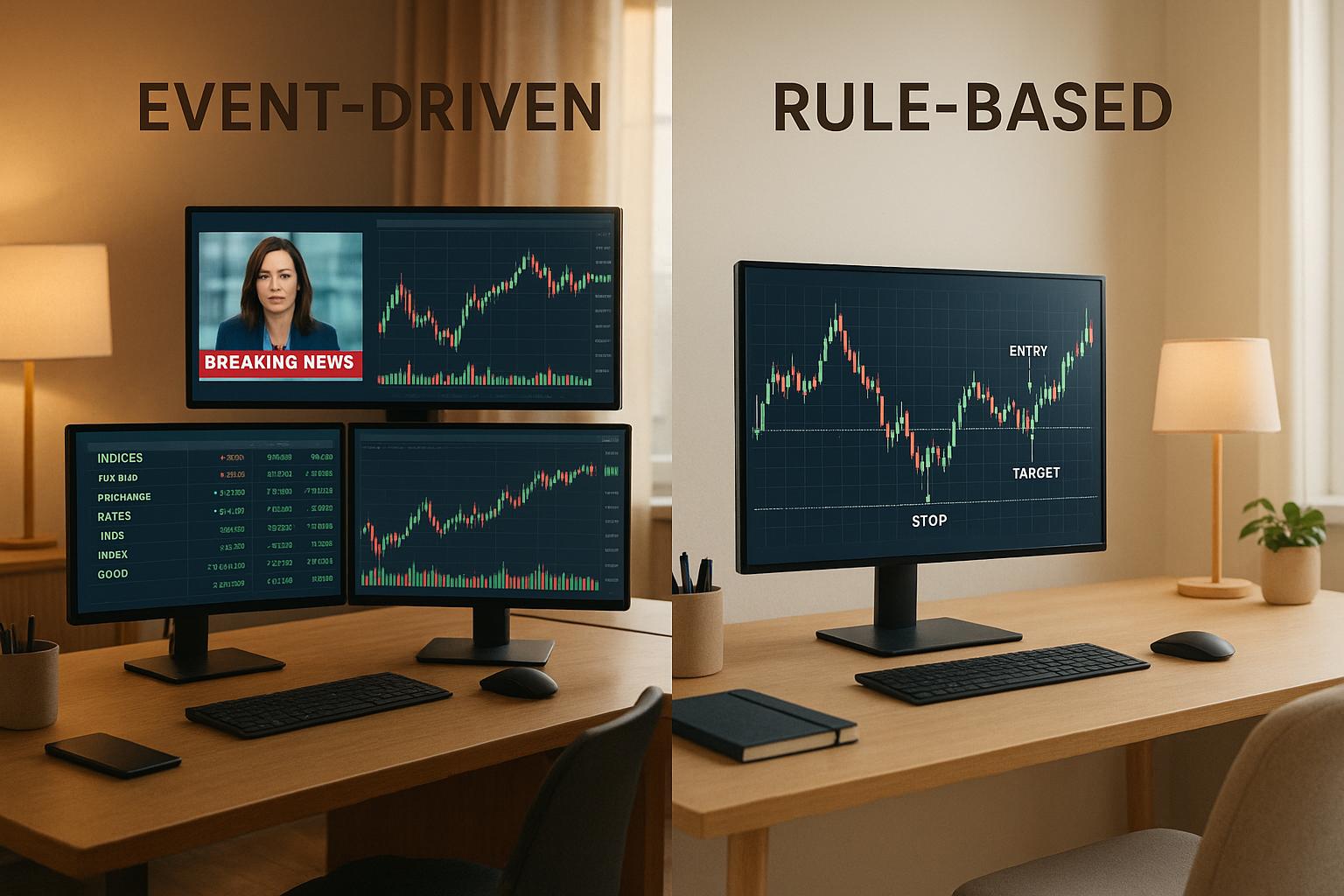Front-running and sandwich attacks are two common ways attackers exploit decentralized finance (DeFi) platforms. Both take advantage of blockchain transparency but differ in their methods and impact:
- Front-running: An attacker places a trade ahead of a pending transaction by paying higher gas fees, profiting from predictable price changes.
- Sandwich attacks: The attacker places a buy order before and a sell order after a victim’s transaction, artificially inflating and then deflating the price to extract profit.
Quick Comparison
| Criteria | Front-Running | Sandwich Attack |
|---|---|---|
| Method | Single trade placed ahead of the victim's transaction | Two trades: one before and one after the victim's trade |
| Profit Mechanism | Exploits price change caused by the victim's trade | Manipulates prices to force the victim into losses |
| Impact on Victim | Higher transaction costs | Significant financial losses |
| Complexity | Simpler, relies on gas fee bidding | More complex, involves coordinated price manipulation |
Key Facts
- Over $1 billion has been siphoned by MEV bots since June 2020.
- Sandwich attacks caused losses of up to 98% in some trades (e.g., $215,500 lost on March 12, 2025).
- Both attacks harm DeFi liquidity pools, increasing slippage and eroding trust.
To protect yourself:
- Set tighter slippage tolerance.
- Use private transaction pools like Flashbots.
- Trade during low network congestion.
Understanding these attacks is essential to safeguard your DeFi investments.
MEV Part 1: Front Running, Back Running & Sandwich Trading
What is Front-Running in DeFi?
In the world of DeFi, front-running disrupts transactions and complicates liquidity management by taking advantage of blockchain transparency. This is achieved through monitoring the mempool, where pending transactions are visible.
How Front-Running Works
Front-running hinges on altering the sequence of transactions. Bots specifically designed for this purpose scan the mempool for large or strategic trades on decentralized exchanges (DEXs). Once they spot a target transaction, they submit a similar one with a higher gas fee, ensuring their transaction is processed first.
Here’s an example: Alice plans to buy a significant amount of Token B using Token A on a DEX. An attacker monitoring the mempool notices her pending trade and quickly submits an identical transaction but with a higher gas fee. Since miners prioritize transactions with higher fees, the attacker’s trade gets executed first. This allows the attacker to purchase Token B at a lower price. When Alice’s transaction goes through, her large order pushes the price of Token B up. The attacker then sells their tokens at this inflated price, pocketing the difference.
A similar tactic occurs during Initial DEX Offerings (IDOs), where attackers use higher gas fees to gain early access to tokens, profiting as prices rise.
This practice has been refined by MEV (Maximal Extractable Value) traders using advanced bots. Since June 2020, these bots have collectively generated over $1 billion in profits across blockchain networks like Ethereum, Binance Smart Chain, and Solana. Around 50 teams are actively engaged in MEV trading, with roughly 10 dominating the space. These top teams can earn anywhere from high five-figure to mid-six-figure profits monthly, with some even hitting millions during favorable market conditions.
These tactics lead to major market disruptions, as explored further in the impact analysis below.
Impact of Front-Running
The consequences of front-running go beyond individual financial losses, striking at the heart of DeFi’s credibility. Victims often end up paying inflated prices for tokens due to price changes triggered by front-running. This can also lead to bidding wars for transaction priority, driving up gas fees and making transactions more expensive for everyday users who might not even realize why fees are spiking.
Front-running also enables broader market manipulation. By preempting large orders, attackers can skew price discovery, which means token prices may no longer reflect genuine market demand. On decentralized lending platforms, attackers employ similar tactics to exploit accounts nearing liquidation. By submitting liquidation transactions with higher gas fees, they can secure collateral at favorable prices, often leaving borrowers worse off.
There are documented cases where a single arbitrage sequence has earned attackers substantial profits, underscoring the severity of front-running. These attacks don’t just harm individuals - they undermine market integrity and introduce systemic risks across DeFi platforms.
What are Sandwich Attacks in DeFi?
Sandwich attacks take front-running to another level by strategically placing trades both before and after a victim's transaction. These attacks exploit the transparency of pending transactions on decentralized exchanges (DEXs) to manipulate asset prices. Unlike basic front-running - where an attacker simply places a trade ahead of the victim - sandwich attacks involve two coordinated trades that effectively "trap" the victim's transaction between them, creating an artificial price distortion.
This tactic has become increasingly popular among those extracting Maximum Extractable Value (MEV). In fact, sandwich attacks were the second most common MEV activity, with transactions totaling over $2 billion in just the first week of January 2024. Over a 30-day period on Ethereum, more than 72,000 sandwich attacks were recorded, targeting over 35,000 victims. Attackers deployed over $8 million to generate approximately $1.4 million in profits.
Let’s break down how these attacks work step by step.
How Sandwich Attacks Work
Sandwich attacks typically unfold in four steps:
- Target Identification: Attackers use bots to scan the mempool (a pool of pending transactions) for large or high-slippage trades.
- Front-Running Transaction: The attacker places a buy order just before the victim’s trade, artificially driving up the asset's price.
- Victim’s Transaction Execution: The victim’s trade goes through at the inflated price, causing them to receive fewer tokens than expected.
- Back-Running Transaction: The attacker immediately sells the asset at the elevated price, pocketing the difference as profit.
For instance, a bot once identified a large Saitama token purchase in the mempool. It executed a sandwich attack by first buying tokens to push up the price, then selling them right after the victim’s transaction. The result? A profit of over $200,000 from the single attack.
Impact of Sandwich Attacks
The ripple effects of sandwich attacks go far beyond individual losses. These attacks distort market prices and erode trust in the DeFi ecosystem. On March 12, 2025, for example, a trader attempted to swap $220,764 worth of USDC for USDT on Uniswap v3. Due to a sandwich attack, they received only $5,271 - an astonishing 98% loss.
Such attacks create a predatory trading environment, making it harder for honest traders to operate. Victims often receive fewer tokens than expected, leading to substantial financial setbacks. To mitigate risks, traders may increase slippage tolerances or pay higher fees, which drives up overall trading costs. Unfortunately, these attacks tend to hit less experienced users the hardest, as they may not fully grasp the complexities and risks of DeFi transactions.
Main Differences Between Front-Running and Sandwich Attacks
Let’s break down how front-running and sandwich attacks differ in their structure, profit strategies, and impact on victims. These differences are key to understanding how each type of attack disrupts traders and liquidity pools.
Transaction Structure Comparison
Front-running operates with a single transaction placed before the victim’s trade. On the other hand, sandwich attacks involve two transactions: one buy order placed before the victim’s trade and one sell order placed immediately after. This two-step process allows attackers to manipulate the price both before and after the victim’s trade is executed. In contrast, front-running relies on monitoring the mempool and quickly submitting a transaction with higher gas fees to get ahead.
How Each Attack Generates Profit
The profit mechanism for these attacks also varies. Front-running takes advantage of anticipated price changes caused by the victim’s trade. It’s an opportunistic approach - attackers position themselves to benefit from the victim’s transaction without directly altering the market. Sandwich attacks, however, are more aggressive. They create artificial price swings, forcing victims to pay inflated prices for their trades. By deliberately distorting the market, sandwich attackers maximize their gains at the victim’s expense.
Effects on Victims
The impact on victims is where these attacks truly diverge. Front-running typically results in higher transaction costs for the victim, but the financial harm is relatively limited. Sandwich attacks, however, can cause much greater damage. Victims are forced to trade at inflated prices, only to see the price drop sharply afterward. This double blow can lead to significant losses. For instance, one trader on Uniswap lost over $700,000 when MEV bots intercepted their transaction, showcasing the devastating potential of sandwich attacks.
These distinctions highlight why understanding the mechanics of both attacks is crucial for managing risks in DeFi liquidity pools.
How These Attacks Affect Liquidity Management in DeFi
Front-running and sandwich attacks wreak havoc on liquidity management in decentralized finance (DeFi). They disrupt the smooth operation of decentralized exchanges, erode trust, and send shockwaves throughout the entire ecosystem.
Automated Market Maker Vulnerabilities
Automated Market Makers (AMMs) are particularly vulnerable because of their predictable pricing algorithms. Unlike traditional exchanges that rely on order books, AMMs calculate token prices based on the balance of tokens in their liquidity pools. This transparency, while essential for decentralization, makes them an easy target for attackers monitoring transactions in the mempool. When a large trade is detected, attackers can predict price adjustments and strategically time their own trades to exploit the system.
Instances of exploitation have been observed at both the retail and validator levels, with significant financial losses for regular users and systematic profit extraction by attackers. These vulnerabilities highlight a critical weakness in the way AMMs operate, leaving liquidity management exposed to manipulation.
Effects on Liquidity Pools
Sandwich attacks, in particular, have a ripple effect on liquidity pools. They can slash revenues for liquidity providers and even reduce the total value locked (TVL) in a pool. A decline in TVL often leads to lower organic trading volumes, further destabilizing the ecosystem. Liquidity providers also face the risk of reverse liquidity provider sandwich attacks, where they are forced to add liquidity at unfavorable rates, amplifying their losses.
The financial toll of these attacks is staggering. Since mid-2020, MEV (Maximal Extractable Value) bots have raked in over $1 billion in profits across Ethereum, Binance Smart Chain, and Solana. One striking example occurred on March 12, 2025, when a trader on Uniswap v3 tried to swap $220,764 worth of USDC for USDT. A sandwich attack left the trader with just $5,271 - an astonishing 98% loss in only eight seconds. Another case on PancakeSwap involved the BH/USDT trading pair, where an attacker manipulated prices to extract liquidity. They paid just $4.16 in fees on the BNB Chain but walked away with approximately $1.27 million in USDT.
These attacks introduce artificial price fluctuations and increase slippage within liquidity pools, making DeFi platforms less appealing to both traders and liquidity providers. The widespread occurrence of sandwich attacks distorts token prices and undermines confidence in decentralized exchanges. Over time, these vulnerabilities threaten not just individual trades but also the broader stability and growth of DeFi liquidity pools.
sbb-itb-00c75f7
How to Protect Against Front-Running and Sandwich Attacks
Front-running and sandwich attacks can be costly for DeFi traders, but there are ways to reduce your risk. The trick lies in understanding how these attacks work and using multiple strategies to safeguard your trades. Here's how you can protect yourself.
Setting Slippage Tolerance Limits
Slippage tolerance is a critical setting that determines the maximum price deviation you're willing to accept for a trade. If this is set too high, attackers can manipulate prices to their advantage, leaving you with fewer tokens than expected. A good rule of thumb is to start with conservative settings and adjust based on the market:
- For highly liquid pairs (e.g., ETH/USDC): Keep slippage between 0.1% and 1%.
- For less liquid or volatile tokens: You may need to increase it slightly, but try not to exceed 5% unless absolutely necessary.
A 2023 study from the University of California showed that using dynamic slippage systems could cut trader losses by 54.7% on average and up to 90% for users with default settings.
Other factors to consider when setting slippage tolerance include:
- Market volatility: Use tighter tolerances during stable periods and widen them when volatility spikes.
- Token liquidity: Stick to lower tolerances for well-established tokens and higher ones for newer, less liquid assets.
- Trade size: Larger trades may require slightly higher tolerances to account for market impact.
- Time of day: Network congestion can slow execution and affect prices, so adjust accordingly.
Using Private Transaction Pools
Another effective way to protect your trades is by keeping transaction details hidden. Services like Flashbots allow you to route trades through private transaction pools, making it harder for attackers to exploit your transactions. This is especially useful for larger trades or if you're frequently targeted by MEV bots.
Trading During Low Network Congestion
Timing is everything when it comes to avoiding attacks. Most attackers strike during high network congestion when gas prices are elevated, and transaction ordering becomes more predictable. To avoid this:
- Trade during off-peak hours, such as early mornings (2–6 AM EST) or weekends, when network activity is lower.
- Split large orders into smaller ones to reduce market impact and make it less appealing for attackers to target your trades.
- Use gas price monitoring tools to identify the best times to execute your trades.
Finally, consider using decentralized exchanges that offer front-running-resistant features like batch auctions or commit-reveal schemes. These mechanisms can also be built into automated trading agents to optimize execution timing and further protect your transactions.
Conclusion
Front-running and sandwich attacks pose distinct challenges within the DeFi space. While sandwich attacks manipulate token prices through coordinated buy-sell orders, front-running takes advantage of pending transactions in the mempool. Both exploit vulnerabilities in transaction visibility and AMM protocols, as highlighted earlier.
MEV bots have raked in substantial profits across networks like Ethereum, BSC, and Solana, often at the expense of everyday investors. In fact, Ethereum users alone faced $1.1 million in losses from sandwich attacks over the past 30 days. These attacks thrive on the visibility of pending transactions, creating a playground for bad actors and undermining trust in DeFi systems.
To safeguard against these threats, a layered defense strategy is essential. Measures such as setting stricter slippage tolerance, using private transaction pools, and trading during periods of lower network congestion can significantly reduce your risk. Additionally, AI-powered solutions are stepping in to offer advanced protection.
AI tools are now being used to identify front-running attempts, predict potential attacks, and automate defensive actions. For example, platforms like AIQuant.fun employ AI-driven trading agents to provide real-time market analysis and automated risk management tailored to address DeFi-specific vulnerabilities.
FAQs
How can I tell if my DeFi transaction might be targeted by a front-running or sandwich attack?
How to Spot and Prevent DeFi Attacks
If you're worried about your DeFi transaction being vulnerable to a front-running or sandwich attack, it's crucial to pay attention to the mempool. The mempool is where pending transactions wait to be processed, and monitoring it can reveal activities that might affect token prices. There are specialized tools available to help you analyze these transactions and detect anything suspicious.
Another important step is setting a slippage tolerance. This feature limits how much the price can change during execution, helping you minimize potential losses. You should also watch for sudden spikes in trading activity around the time of your transaction, as this could signal malicious behavior.
By staying alert and using the right tools, you can better protect your trades from these kinds of tactics.
How can I protect myself from sandwich attacks when trading in DeFi?
How to Reduce the Risk of Sandwich Attacks in DeFi Trading
Protecting yourself from sandwich attacks in the world of DeFi trading requires a proactive approach. Here are some effective strategies to help safeguard your trades:
- Lower your slippage tolerance: Adjusting your slippage settings to a lower threshold makes it more difficult for attackers to manipulate your trades. High slippage settings are often the primary target for such exploits.
- Split large trades into smaller ones: Breaking down hefty transactions into smaller chunks can reduce their visibility in the market. This approach makes your trades less noticeable and less appealing to potential attackers.
- Leverage private transaction tools: Some platforms offer tools that allow you to execute transactions privately, keeping them out of the public mempool. This added layer of privacy can significantly reduce the risk of interception.
- Trade during quieter periods: Timing is key. Executing your trades during low-traffic times means fewer eyes on the mempool, decreasing the chances of being targeted.
By using a combination of these tactics, you can enhance the security of your trades and stay one step ahead of potential sandwich attacks in DeFi markets.
What are the differences between front-running and sandwich attacks, and how do they affect trust and liquidity in DeFi?
Front-Running and Sandwich Attacks: A Threat to DeFi
Front-running and sandwich attacks are two underhanded tactics that take advantage of how transactions are ordered on decentralized exchanges (DEXs). These schemes can shake trader confidence and disrupt liquidity in the decentralized finance (DeFi) space.
Front-running happens when an attacker spots a pending transaction and sneaks in their own order ahead of it, profiting from the resulting price changes. Sandwich attacks take this a step further: the attacker places a buy order just before a victim's large trade, driving up the price, and then immediately follows up with a sell order to cash in on the inflated value. Both strategies exploit the transparent nature of blockchain transactions, turning openness into a vulnerability.
The fallout? These attacks create an uneven playing field, making trading feel rigged. When traders lose money to such schemes, they may think twice about participating, which drains liquidity from the market. This erosion of trust doesn't just affect individual users - it can stall the growth and adoption of DeFi as a whole, making it less attractive for everyone, from newcomers to seasoned investors.


